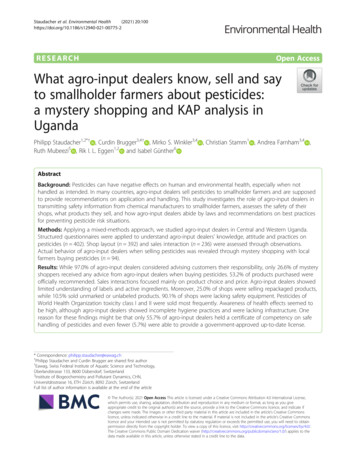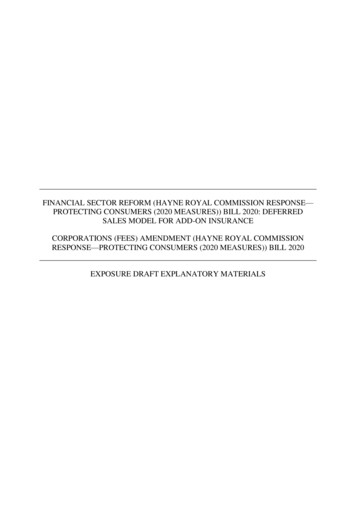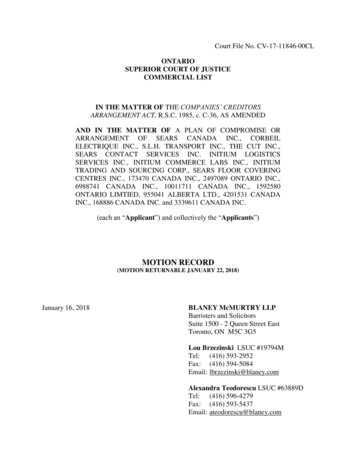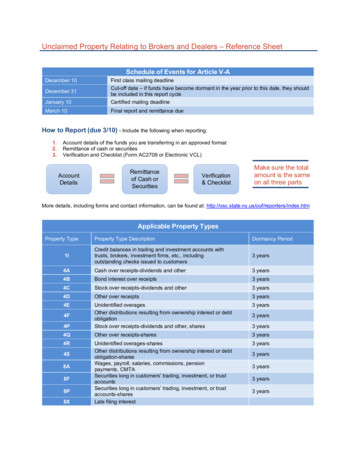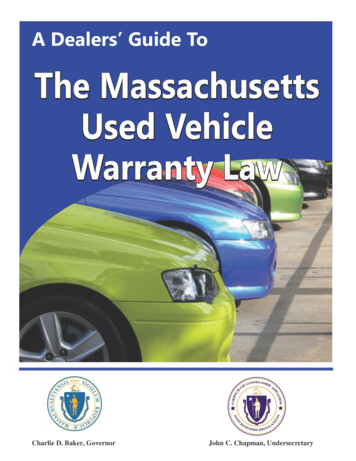
Transcription
A Dealers’ Guide ToThe MassachusettsUsed VehicleWarranty LawCharlie D. Baker, GovernorJohn C. Chapman, Undersecretary
A DEALER’s GUIDE TO THE MASSACHUSETTSUSED VEHICLE WARRANTY LAWThe Massachusetts Used Vehicle Warranty Law, G.L. c. 90, § 7N ¼, (General Laws chapter 90,section 7 N ¼) has been in effect since July 1, 1988, but consumers and dealers still often have questionsabout particular provisions of the law. This guide is written to provide information for dealers, to ensurethat new dealers coming into the marketplace are aware of their obligations under the law. For individuallegal advice, dealers should contact private counsel. Additional information about the law and aboutother consumer laws related to motor vehicles is available on the Consumer Affairs web site:www.mass.gov/consumerFocus of the LawThe Used Vehicle Warranty Law is intended to provide certain warranty rights to consumers whopurchase a vehicle costing 700 or more, from a dealer. A “dealer” is specifically defined under thelaw—you qualify as a dealer if you have sold more than three vehicles in the preceding 12 months.Under the law, you must provide a Massachusetts-specific written warranty to consumerpurchasers. The law also requires dealers to buy back vehicles under certain conditions, if the vehicle hasa defect that impairs use or safety and cannot be repaired by the dealer within three repair attempts forthe same defect, or the vehicle is out of service for more than 10 business days.Vehicles Covered by the Law A used car, van or truck that is sold by a Massachusetts new or used car dealer, for 700 or more,that has fewer than 125,000 miles on the odometer when it is sold.To qualify for the 700 exemption, these costs must total less than 700: the purchase price of thevehicle, including any trade-in and/or over-allowance; the cost of any options purchased from orthrough the dealer; the cost of preparing the vehicle for its sale and delivery to the consumer; andany other costs related to the sale that the consumer paid to the dealer.Not included in the 700: sales or excise tax, finance charges*, registration fees, the cost of anyextended warranty or service contract, and the cost of motor vehicle insurance.*Note: Any motor vehicle dealer who finances the sale of a vehicle under a retail installmentcontract and holds the contract, must obtain a sales finance company license from theDivision of Banks pursuant to G.L. c. 255B. This applies regardless of whether you arecharging interest on the sale. Demonstrator/fleet/executive vehicles are covered by the Used Vehicle Warranty Law butconsumers who qualify for both new and used car arbitration must seek relief from themanufacturer under the new car Lemon Law before seeking relief from you under the UsedVehicle Warranty Law.When a consumer buys a demonstrator/fleet/executive vehicle, the new car Lemon Law,G.L. c. 90, §7N ½ covers the vehicle for the remainder of the first year from the date thedealer or manufacturer first puts the vehicle into regular use (the “in-service” date), or15,000 miles, whichever comes first.To qualify for arbitration under the new car Lemon Law, a consumer must have his carrepaired by the manufacturer three or more times for the same substantial defect, or thevehicle must be out of service for repair of a substantial defect or combination of defects2
for fifteen (15) or more business days. Repairs must be made within one year of theoriginal “in-service” date or within 15,000 miles, whichever comes first.The consumer’s request for new car arbitration must be received by the new car LemonLaw arbitration program at the Office of Consumer Affairs and Business Regulation withineighteen (18) months of the date the consumer takes delivery of the vehicle.A consumer who owns a demonstrator/fleet/executive vehicle may use the Used VehicleWarranty Law only if he does not qualify to be accepted for the New Car Lemon Lawprogram. Antique/classic cars are covered by this law, if they are sold for 700 or more, with fewer than125,000 miles on them at the time of sale. There is no specific exemption provided for themunder the law. Salvage title vehicles are also covered by this law if they are sold for 700 or more, with fewerthan 125,000 miles on them at the time of sale. They are also covered by the “Lemon Aid” law,G.L. c. 90, § 7N. There is no specific exemption provided for salvage title vehicles under either ofthese laws.Vehicles NOT Covered by the Law Motorcycles, mopeds, dirtbikes; Vehicles sold for less than 700; Vehicles sold with more than 125,000 miles on the odometer (Note: it is a violation of state andfederal law to alter odometer readings or to tamper with an odometer); Leased vehicles (unlike the new car Lemon Law, which covers leased vehicles); Previously leased vehicles that are subsequently sold are specifically exempted from the usedvehicle warranty law, but only if the vehicle is sold to the lessee, a family member of the lessee, oran employee of the lessee; Any vehicle used primarily for business purposes, or purchased by, owned by or registered to abusiness; and Auto homes, and vehicles built primarily for off-road use (ATVs and “dune buggies”)DISCLAIMER/DISCLOSUREYou cannot disclaim your obligations under this required state warranty, and telling the consumerabout known defects does not excuse you from your responsibility to repair problems under the warranty.You cannot ask a consumer to give up his or her rights under the Used Vehicle Warranty law. Astatement or notice that the consumer has given up his rights under this law does not excuse you fromyour obligation to give the consumer a warranty, or your obligation to repair covered defects. This is trueeven if the consumer signs such a statement.Private party salesA “private party sale” is a sale between two non-dealers. The Used Vehicle Warranty lawprovides that for such transactions, a private party seller must disclose known defects to purchasers. If thepurchaser can prove that a seller knew about a defect which impairs the used vehicle’s safety orsubstantially impairs its use, the purchaser can notify the seller he is cancelling the sale within thirty (30)days after the sale. The purchaser is entitled to the return of all monies paid to the seller, less a deductionfor use of fifteen (15) cents a mile. If the purchaser ends up suing the seller, and the court finds that anoffer of settlement made by the seller in response to a refund request from the purchaser was not3
reasonable, the purchaser can also recover attorney’s fees and costs from the seller, but if the court findsthat the lawsuit was frivolous or not in good faith, the seller can recover attorney’s fees and costs from thepurchaser. Private party sellers are not required to repair vehicles. Private party sellers must also complywith the Lemon Aid law (sales cancellation), but not with the Implied Warranty of Merchantability or theImplied Warranty of Fitness for a Particular Purpose, as consumers are not “merchants,” nor generallywith the Consumer Protection Act, since consumers are not customarily engaged in trade or commercesimply by selling their own vehicles.The WarrantyWhat is covered by the Used Vehicle WarrantyYou as the dealer are responsible under this law for all parts and labor necessary to repair anydefects or malfunctions, or combination of defects or malfunctions, which impair a vehicle’s use or safety.In deciding whether a defect or malfunction impairs safety, determine whether the defect or malfunctioncreates or has the potential to create danger to the consumer, the passengers, to others, or to property.You can charge a consumer a fee of up to 100 for repair of all defects during the warranty period. Thatis, the most you can charge for any one vehicle is 100, and in order to do this, you must have stated onthe consumer’s copy of the warranty the amount (up to 100) that may be charged. If you do not statean amount on the warranty, you cannot charge the consumer anything at all for repair of qualifieddefects during the warranty period.Length of WarrantyThe length of the dealer warranty depends on how many miles are on the vehicle when you sell it.MileageattimeofPurchaseFewer than 40,000 miles40,000 to 79,999 miles80,000 to 124,999 miles125,000 miles or overWarranty(whichevercomesfirst)90 days or 3,750 miles60 days or 2,500 miles30 days or 1,250 milesImplied Warranty onlyIf the true mileage cannot be determined at the time of the sale, the length of warranty willdepend on the age of the vehicle. To determine the vehicle’s age, subtract the model year from the year inwhich you sell the vehicle. For example, if you sell a 2006 vehicle in 2010, the vehicle is 4 years old, andaccording to the law (shown in the table below), the vehicle would have a 60 day/2,500 mile warranty.AgeofVehicle3 or fewer years oldMore than 3 but fewer than 6 years old6 or more years oldWarranty(whichevercomesfirst)90 days or 3,750 miles60 days or 2,500 miles30 days or 1,250 milesWhen counting days, the day you give the consumer the warranty counts as the first day, so, forexample, a warranty given on September 1 expires on September 30.What is NOT covered by the Limited Used Vehicle WarrantyYou are not responsible under the Used Vehicle Warranty law for the following defects: Defects that affect only appearance; Defects that do not impair use or safety;4
Defects covered by the manufacturer’s express warranty if it has been transferred to the consumerand you assure that the manufacturer makes the repairs;Defects caused by consumer negligence or abuse;Damage caused by accidents unrelated to the defect, or by vandalism or repair attempts made bysomeone other than you, your agent, or the manufacturer; andDefects caused by substantial changes the consumer made to the vehicle (such as installing a liftkit, sunroof, or parts like carburetors or exhaust systems that were not part of the vehicle when yousold it).You should be prepared to prove that negligence, vandalism, accident, unauthorized repair ormodification caused the problem, if you allege that this is the case. Simply stating that one of theabove reasons caused the problem will not be enough for arbitration or a court challenge.Note: Under the law, the dealer may repair a vehicle either by performing the repair directly, or byarranging and paying for prompt repair by someone else. During the repair period, the dealer is alsoresponsible for paying the reasonable costs of towing the vehicle from the point of breakdown up to thirty(30) miles, in order for the consumer to obtain required repairs or to return the vehicle to the dealer.Time Periods: “Business Day,” “Tolling,” Extensions of the WarrantyBusiness Day: The Used Vehicle Warranty law defines Monday through Friday, inclusive, as “businessdays” but excepts state or federal holidays. This term is especially important in determining the length oftime a consumer’s vehicle has been out of service. When counting the number of business days a vehiclehas been out of service, any part of a business day will count as a whole day. In contrast, “day,” whenused in the statute to describe warranty periods, means calendar days, Sunday through Saturday.Tolling: Tolling refers to the stopping of time-counting during the warranty period, or to adding extradays to the warranty or return period because of a particular event. While under other laws, one day ofthe warranty may be used up for every day the consumer owns the vehicle, under the Used VehicleWarranty law, each day a car is in your shop does not use up a day of the warranty. There are at leastnine situations where: Days are added to the warranty period, or Days are added to the return period, or Days waiting for a repair appointment do not count toward meeting the 3 repair/more than 10business days required by the law, or Days in the shop for repairs do not count toward meeting the three repair/more than 10 businessday requirement of the law, or Days out of service when the vehicle is not in the dealerʼs shop count toward meeting the 3repairs/more than 10 business days required by the law.Examples of TollingRepair/WarrantyFacts1) Car in dealer’s shop2) Days in dealer’s shopwhile waiting for partsto be delivered.Number of Days Addedto Consumer’s WarrantyNumber of days in shopDays that count as BusinessDays out of ServiceNumber of business days in for dealerwarranty repairs.Number of days in shopOnly business days before apart is ordered, and on orafter a part is received, or5
while other defects are beingfixed when a part is on order.But Note: Only a maximum of 21 calendar days for parts orders during the warranty period do not counttoward the more than 10 business day requirement.3) Car leaves dealer’s shop 30 days from date repairwith fewer than 30 dayscompleted for that defectleft in warrantyonly;Number of business days inshop.4) Return of vehicle to shop 30 days from date repairwithin 5 business dayscompleted for that defectafter warranty expiredonlyNumber of business days inshop.5) Dealer refuses toaccept vehicle forrepair when presentedNumber of days waitingfor repairNumber of business daysduring the waiting period.6) Repair covered bymanufacturerʼs warrantyNumber of days in shopNone7) Dealer fails to giveconsumer correctwritten warrantyNumber of days fromdelivery until consumerreceives the warrantyNone8) Dealer fails to takevehicle within 3 businessdays of a telephoned orwritten request for repairNumber of days waitingfor repairBusiness days only duringthe waiting period.9. Vehicle cannotReasonably be returnedto shop by consumerduring return periodExtend the return period byone day for each day untilthe vehicle can reasonablybe returned.NoneBut note: As previously stated, when the word “day” is used in above chart, rather than “business day,”it means calendar day – Sunday through Saturday, inclusive.Examples of tolling situations:1) FACTS: The car you sold on September 1st has a 60 day warranty. On Friday, September 24,through Monday, September 27th, the car is in the shop for repair of the brakes.CALCULATION: Add four (4) days to the 60 day warranty for the four (4) calendar days the carwas in the shop. The warranty would otherwise have expired on October 30, but now lasts untilNovember 3. (Remember, October has 31 days; you need to consider the length of the month youare in when calculating.) But, in this situation, count only the two (2) “business days” in the shop,Friday and Monday, toward the more than 10 business day requirement of the law.6
51219266132027SeptemberSMTWTF1 2 37 8 9 1014 15 16 1721 22 23 2428 29 30S4111825OctoberSMTWTFS13 4 5 6 7 810 11 12 13 14 1517 18 19 20 21 2224 25 26 27 28 2931291623302) FACTS: The car you sold on September 1st has a 30 day warranty. The car goes into the shop forbrake repairs on Tuesday, September 28 and the repair is finished on the 29th.CALCULATION: Add two (2) days to the 30 day warranty for the two (2) calendar days the carwas in the shop. The warranty on the car as a whole would have expired on September 30, butnow lasts until October 2. Also, the warranty for brake defects only is extended 30 days from thedate that the repair was completed, until October 28. Finally, count the two (2) business days thecar was out of service (the 27th and 28th) toward the more than 10 “business day” limit for days outof service.3) FACTS: The car you sold on September 1st has a 60 day warranty. On Friday, September 24, thecar is brought in for brake repairs. On that day, you discover that several parts needed for repairsare out of stock, so you order them (keep copies of your order slips for the consumer). The partsarrive on Thursday the 30th and you finish the repair on Friday the 1st of October.CALCULATION: Even though the car has been in the shop for six (6) business days (24, 27, 28,29, 30, 1), only two (2) business days (Thursday the 30th and Friday the 1st—the “on or after a partis received” days, as you ordered the parts the day the car came in) count toward the more than 10business day limit for days out of service.NOTE: The dealer must order the part on the day he reasonably knew that the part was needed,and he must give the consumer a written receipt when the consumer picks up the car, listing thedates the part were ordered and received, and other written evidence of the parts order.If you refuse to repair the vehicleIf a consumer asks you to repair a problem and you refuse, the vehicle is considered out of servicebeginning on the day you refuse repairs if the consumer can later show that a defect that impaired use orsafety did exist. Business days out of service will count toward the 3 repairs/more than 10 business daysrequired by the law and the consumer could eventually qualify for a buyback under the law.BuybackDealer Option to Buy BackIf you would prefer to buy the car back from the consumer instead of making repairs you arepermitted to do so under the Used Vehicle Warranty law. You will need to pay the full repurchase priceless a reasonable allowance for use of fifteen (15) cents a mile for each mile the vehicle has been drivenbetween the sale and your repurchase. The consumer is responsible for proving his or her reimbursementcosts to you by giving you copies of receipts and other supporting documentation. The consumer has theoption of continuing to use the car until such time as you make the full refund, but the miles put on beforeyour buyback may also be subtracted from the repurchase price.7
If you offer the consumer a full refund under the law, and the consumer refuses to allow thebuyback, the consumer’s rights under the Used Vehicle Warranty law will be limited. The consumer willnot be entitled to further dealer warranty repairs, but may seek repairs under the implied warranty ofmerchantability. If the dealer is required to, or chooses to, repurchase a vehicle, the consumer and dealerare required by the law to cooperate with each other to execute all necessary documents in order to clearthe title of any encumbrances on the repurchased vehicle.In order to make a buyback offer, while you may initially make such an offer orally, you mustfollow up with an offer in writing. It is wise to send the written offer by certified mail, return receiptrequested, or by registered mail, and save a copy of the letter and return receipts and other trackinginformation for your records. You must allow the consumer at least five (5) business days to respond toyour offer. If the consumer does not respond to your offer in that time, you should write again to theconsumer to confirm that you made an offer and that you have not received the consumer’s response.This communication should also be sent by certified mail, return receipt requested, or by registered mail,keeping a copy of the letter, and the receipts, for your records.If the consumer accepts your offer, you should give the consumer the full refund as soon as theconsumer can give you clear title to the vehicle. If there is a lien on the vehicle, you and the consumershould work together to make any necessary arrangements to pay off the loan. You are not permitted torequire the consumer to take out a loan in order to give you back the title. You may have to pay thelienholder all or a portion of the refund toward the loan balance to free up the title.Refund CalculationsWhether you offer on your own to buy back a vehicle, or an arbitrator orders a refund, take thesteps outlined below to estimate or calculate the amount you are required to refund under the UsedVehicle Warranty law.Add: The purchase price (including the amount for the trade-in—in the case of an over-allowance--therepurchase amount will be reduced by the amount of any over-allowance on a trade-in vehicle ifthe amount of the over-allowance and the actual cash value of the trade-in are separately statedand so specifically identified on the copy of the motor vehicle purchase contract or bill of sale orother document given to the consumer prior to or at the time of sale) Finance charges; Registration fees; The pro-rata amount of payments toward motor vehicle damage, collision and comprehensiveinsurance; The non-refundable portion of payments made for credit life, and credit accident and healthinsurance on the vehicle loan; The non-refundable portion of payments made for any extended warranties and service contracts; Unreimbursed towing costs up to a distance of thirty (30) miles; Up to 15 a day for rental cars, trains, taxis, buses, etc. when the car is out of service, startingwhen the vehicle is out of service, starting on the 3rd day of a repair attempt; Payments made toward the 100 repair deductible; and Other costs related directly to the defect.8
Subtract: A use allowance of 15 cents per mile for every mile driven from the time of delivery of the vehicleto the date the refund is given, but not including miles put on the vehicle by you during repairattempts (mileage at return, minus mileage at purchase, minus repair mileage, multiplied by .15 use allowance); and The amount of an over-allowance, if any.Additional expenses not required to be reimbursed:You are not required to pay the consumer’s lawyer’s fees, lost wages, excise or sales tax, or other coststhat are not directly related to the defect.Returning trade-in:If you still own the trade in vehicle, and it is in the same condition as when the consumer traded it in, youmay return the trade-in vehicle itself, rather than paying the consumer the amount allowed for the trade-in.You still must pay the consumer the other repurchase amounts. If you return the trade-in, the amount ofany over-allowance will not be deducted from the repurchase amount.Getting TitleIf you are repurchasing a vehicle and the title has not yet been processed, the consumer can ask theRegistry of Motor Vehicles to withdraw his or her application for title. The consumer can then return thetitle to you in exchange for the refund—but the consumer can only withdraw an application for title if theRegistry has not yet begun to process it.If you are repurchasing the vehicle and the Registry has already processed the consumer’sapplication for title, but it has not yet been issued to the consumer or his or her lender, the consumer canrequest that the Registry expedite the title. The consumer should contact the Registry of Motor Vehicles’Title Division. While usually it takes 30 days to process and issue a title, this process could shorten thattime. Once the consumer gets the title, it can be signed over to you.If the consumer has a loan on the vehicle, the title will be issued in the name of the lienholder(lender). The consumer will need to get a lien release from the lender so the Registry can issue the title inthe consumer’s name, so that the consumer can sign over the title to you. You may need to give thelender the portion of the refund that is owed on the consumer’s loan before the lender will agree to releasethe title.Damage to vehicleIf a vehicle is damaged beyond reasonable wear and tear through no fault of the dealer ormanufacturer, and that damage is unrelated to the defect, the consumer must either repair the damage, payyou for the reasonable cost of repair, or allow you to deduct the reasonable cost of repair from therepurchase price.ADDITIONAL LAWS—LEMON AID LAW, AND THE IMPLIED WARRANTY LAWSThe Used Vehicle Warranty Law does not limit a consumer’s rights under the Lemon Aid law (7day inspection law—voiding contracts of sale), or under the Implied Warranty of Merchantability. Bothof these laws will apply to your used car sales in addition to the Used Vehicle Warranty Law. Lemon Aid law, G.L. c. 90, § 7N: Under this law, if the vehicle you sold to the consumer failsMassachusetts motor vehicle inspection within seven days of the sale, and the defects in thevehicle were not caused by abusive or negligent operation of the vehicle by the consumer or by9
damage resulting from an accident after the date of sale, and if the cost of repairs necessary to passinspection exceeds ten percent (10%) of the purchase price of the vehicle, the consumer may voidthe sale, and you must refund the purchase price of the vehicle, unless you and the consumer agreein writing that you will make the necessary repairs at your own cost within a reasonable period oftime. Implied Warranty of Merchantability: G.L. c. 106, § 2-314: Under this law, the goods sold bya merchant must be fit for ordinary purposes for which such goods are used. You must alsoconform to any promises or affirmations of fact you make, either by word or by label or otherrepresentation. Implied Warranty of Fitness for a Particular Purpose: G.L. c. 106, § 2-315: Under this law,if the seller-dealer has reason to know of any particular purpose for which the vehicle is requiredand that the buyer is relying on the seller-dealer’s skill or judgment to select or furnish the vehicle,there is an implied warranty that the vehicle will be fit for that purpose.Note: You cannot disclaim any of these laws in sales made to a consumer.NOTICES and DOCUMENTS FOR CONSUMERSThe Used Vehicle Warranty Law and other laws applicable to motor vehicle sales requireyou to post notices, and to provide certain written information to consumers.When you offer a vehicle for sale on your lot, you must place on the window or dashboard ofthe car: A yellow sticker outlining the Used Vehicle Warranty Law;The federal Buyer’s Guide (required on window).The yellow sticker:The yellow sticker, which must be placed on the window or dashboard, must say, in at least tenpoint type:ATTENTION CONSUMERSThe Massachusetts Used Car Warranty Law, General Laws Chapter 90, Section 7N ¼, protectsconsumers who have problems with their used vehicle.UNDER THE LAW, YOU HAVE A RIGHT TO A REFUND IF:(a) a defect that impairs safety or use arose during the warranty period, AND(b) the defect continued to exist or has recurred during the warranty period after either:1. three or more repair attempts for the same defect, or2. being out of service after being returned for repair for any defect for a cumulative totalof more than 10 business daysIF THE DEALER DOES NOT ISSUE A REFUND, YOU HAVE A RIGHT TO HAVE YOURCASE ARBITRATED BY THE STATE IF YOU APPLY WITHIN SIX MONTHS AFTERDELIVERY OF THE VEHICLE.1010
FOR MORE INFORMATION, REFER TO THE USED CAR WARRANTY LAWINFORMATION PROVIDED WITH YOUR OWNERSHIP MATERIALS, OR CONTACT:Used Car Warranty Law Arbitration ProgramOffice of Consumer Affairs and Business Regulation10 Park Plaza, Room 5170Boston, MA 02116Used Car Warranty Law Information: 617- 283-8787OrOffice of the Attorney General: 617-727-8400The Federal Buyer’s GuideThe federal Buyers Guide is a requirement of the Federal Trade Commission’s Used Ca rRule, 16 CFR part 455. You must post a Buyers Guide on the vehicle before you "offer" a usedvehicle for sale. A vehicle is offered for sale when you display it for sale or let a customer inspectit for the purpose of buying it, even if the car is not fully prepared for delivery. This requirementalso applies to used vehicles for sale on your lot through consignment, power of attorney, or otheragreement. At public auctions, dealers and the auction company must comply. The Rule does notapply at auctions that are closed to consumers. Below is the text of the Buyerʼs Guide required inMassachusetts. You cannot use the version of the Buyer’s Guide which states “as-is, nowarranty,” as all vehicles in Massachusetts sold by a dealer are subject to, at a minimum, theimplied warranty of merchantability.1111
BUYERS GUIDEIMPORTANT: Spoken promises are difficult to enforce. Ask the dealer to put all promises in writing. Keep this form.VEHICLE MAKE MODEL YEAR VIN NUMBERDEALER STOCK NUMBER (Optional)WARRANTIES FOR THIS VEHICLE:IMPLIED WARRANTIES ONLYThis means that the dealer does not make any specific promises to fix things that need repair when you buy the vehicle or after the time ofsale. But, state law “implied warranties” may give you some rights to have the dealer takecare of serious problems that were not apparentwhen you bought the vehicle.WARRANTYFULL LIMITED WARANTY. The dealer will pay% of the labor and% of the parts for the covered systems that fail during thewarranty period. Ask the dealer for a copy of the warranty document for a full explanation of warranty coverage, exclusions, and the dealer’srepair obligations. Under state law, “implied warranties” may give you even more rights.SYSTEMS COVERED: DURATION:SERVICE CONTRACT. A service contract is available at an extra charge on this vehicle. Ask for details as to coverage, deductible, price, andexclusions. If you buy a service contract within 90 days of the time of sale, state law “implied warranties” may give you additional rights.PRE PURCHASE INSPECTION: ASK THE DEALER IF YOU MAY HAVE THIS VEHICLE INSPECTED BY YOUR MECHANIC EITHER ON OROFF THE LOT. SEE THE BACK OF THIS FORM for important additional information, including a list of some major defects that may occur in usedmotor vehicles.Frame & BodyFrame-cracks, corrective welds, or rusted throughDog tracks—bent or twisted frameEngineOil leakage, excluding normal seepageCracked block or headBelts missing or inoperableKnocks or misses related to camshaft lifters and push rodsAbnormal exhaust dischargeTransmission & Drive ShaftImproper fluid level or leakage, excluding normal seepageCracked or damaged case which is visibleAbnormal noise or vibration caused by faulty transmission or drive shaftImproper shifting or functioning in any gearManual clutch slips or chattersDifferentialImproper fluid level or leakage excluding normal seepageCracked of damaged housing which is visibleAbnormal noise or vibration caused by faulty differentialCooling SystemLeakage including radiatorImproperly functioning water pumpElectrical SystemBattery leakageImproperly functioning alternator, generator, battery, or starterFuel SystemVisible leakageWheelsVisible
The consumer's request for new car arbitration must be received by the new car Lemon Law arbitration program at the Office of Consumer Affairs and Business Regulation within . Warranty Law only if he does not qualify to be accepted for the New Car Lemon Law program. Antique/classic cars are covered by this law, if they are sold for 700 .




